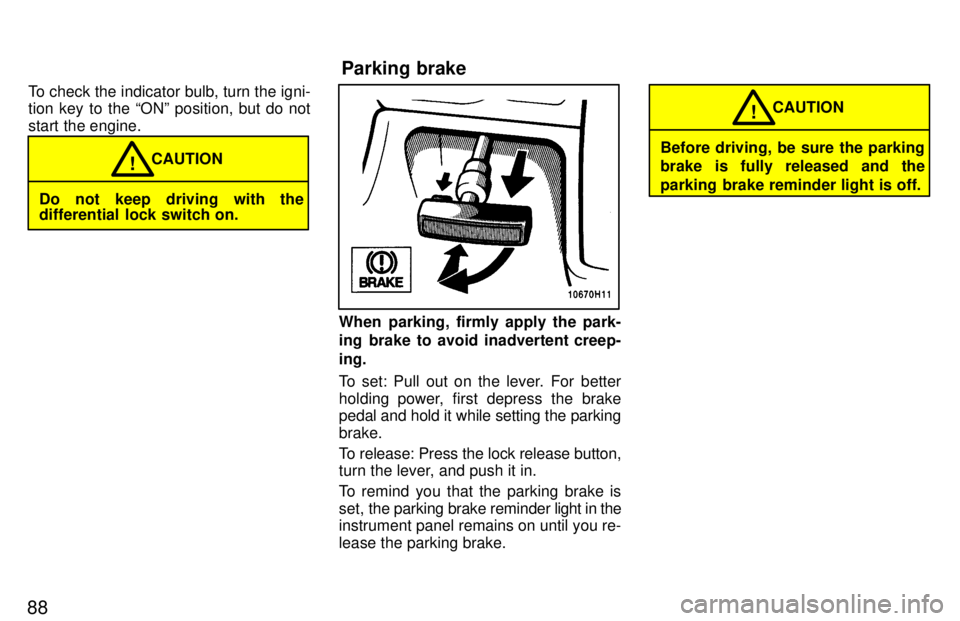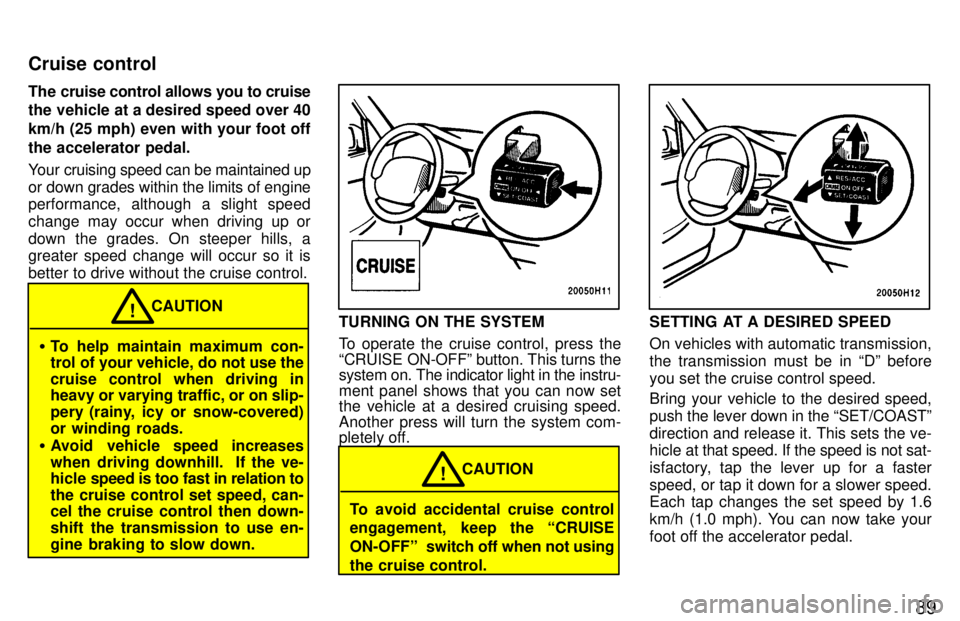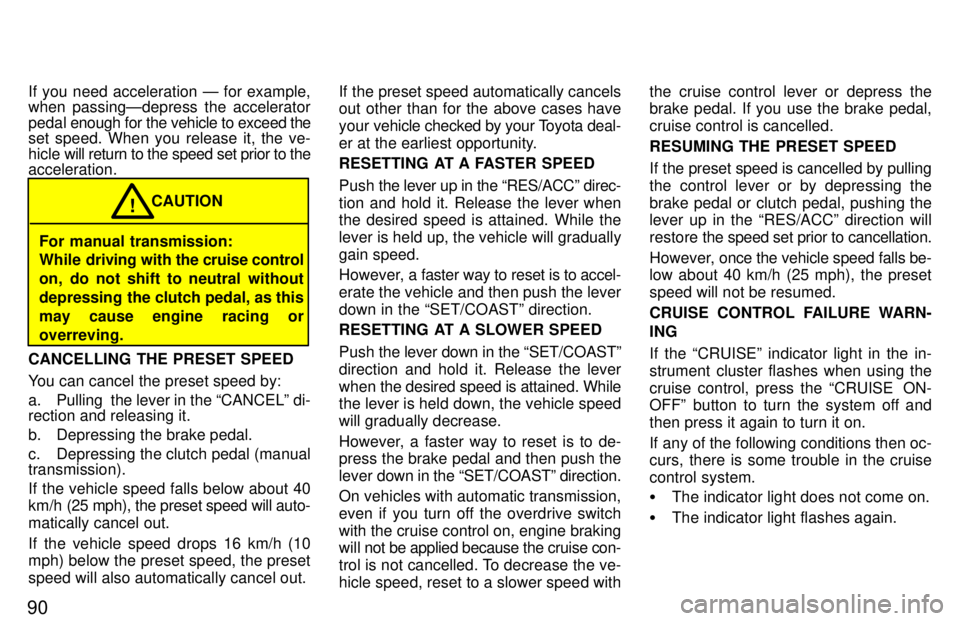1997 TOYOTA TACOMA light
[x] Cancel search: lightPage 86 of 221

85
To shift from H4º to H2º
, push the
4WDº button aging to turn it off.
This can be done at any vehicle speed.
You need not depress the clutch pedal.
If the indicator light does not go off when you shift the transfer into H2º, drive
straight ahead while accelerating or de- celerating, or drive in reverse. SHIFTING BETWEEN H2º OR H4º
AND L4º
To shift from H2º or H4º to L4º
, stop
the vehicle or reduce your speed to less
than 8 km/h (5 mph). With your foot off the
accelerator pedal, depress the clutch
pedal and move the front drive control le-
ver.
To shift from L4º to H2º or H4º , de-
press the clutch pedal and move the front
drive control lever. When the 4WDº but- ton is pushed in, the transfer shifts into
H4º; when the button is left out, the trans-
fer shifts into H2º This can be done at any vehicle speed.
If the indicator light does not go off when you shift the transfer into H2º, drive
straight ahead while accelerating or de- celerating, or drive in reverse. SHIFTING BETWEEN H2º and H4º
To shift from H2º to H4º
, reduce your
speed to less than 100 km/h (62 mph) and
push in the 4WDº button.
If the indicator light does not come on
when you push in the 4WDº button, drive
straight ahead while accelerating or de- celerating.
If the indicator light flashes and the buzzer
sounds when you push in the 4WD: but-
ton, reduce your speed or stop the vehicle
and reset.
Never push the 4WDº button if
wheels are slipping. Stop the
slipping or spinning before shifting. CAUTION
!
(d) Shifting procedure (lever/button type withautomatic transmission)
Page 87 of 221

86To shift from H4º to H2º
, push the
4WDº button again to turn it off. This can be done at any vehicle speed.
If the indicator light does not go off when you shift the transfer into H2º, drive
straight ahead while accelerating or de-celerating, or drive in reverse. SHIFTING BETWEEN H2º OR H4º AND L4º
To shift from H2º or H4º to L4º
, stop
the vehicle and put the transmission in
Nº. With your foot holding down the brake
pedal, move the front drive control lever.
To shift from L4º to H2º or H4º , stop
the vehicle and put the transmission in
Nº. With your foot holding down the brake pedal, move the front drive control
lever. When the 4WDº button is pushed in, the transfer shifts into H4º; when the button is left out, the transfer shifts intoH2º.
If the indicator light does not go off when you shift the transfer into H2º, drive
straight ahead while accelerating or de- celerating, or drive in reverse.
The rear differential lock system is
provided for use only when wheel
spinning occurs in a ditch or on a slip-
pery or ragged surface.
This differential lock system is effective in case one of the rear wheels is spinning.
Before using the rear differential lock sys-
tem, first shift the front drive control into L4º with the free-wheeling hubs engaged
to see if it works. If this has no ef fect, addi-
tionally use the rear differential lock sys-tem.
Rear differential lock system
Page 88 of 221

87
Do not use the rear differential lock
in the conditions other than above.
Large steering effort and careful
cornering control will be required.CAUTION
!
To lock the rear differential, push the switch.
Be sure to stop the wheels before locking
the differential.
For easy locking, depress the clutch ped- al,
push the lock switch and slowly release
the clutch pedal.
The indicator light will blink when the
switch is turned on. Wait a few seconds for
the system to complete operation. After
the differential is locked, the light will stop
blinking and remain on.
The anti-lock brake system does not op-
erate when the rear differential is locked.
It is normal operation for the ABSº warn-
ing light to be on at this time.
� Do not lock the differential until
the wheels have stopped spin-
ning. Otherwise, the vehicle may
move in an unexpected direction
when the differential lock is en-
gaged, resulting in an accident.
This may also lead to possible
damage to differential lock com-
ponent parts.
� Do not drive over 8 km/h (5 mph)
when the differential is locked. CAUTION
!
To unlock the differential, push the
switch once again.
Unlock the differential as soon as the ve- hicle moves out.
For easy unlocking, slightly turn the steer-
ing wheel in either direction while the ve- hicle is in motion.
When the differential lock is disengaged, the indicator light will go out.
The differential will also unlock if you shift
the front drive control lever out of L4º. Never forget to turn off the switch after us-
ing this feature.
Page 89 of 221

88To check the indicator bulb, turn the igni-
tion key to the ONº position, but do not
start the engine.
Do not keep driving with the
differential lock switch on.
CAUTION
!
When parking, firmly apply the park-
ing brake to avoid inadvertent creep- ing.
To set: Pull out on the lever. For better
holding power, first depress the brake
pedal and hold it while setting the parking brake.
To release: Press the lock release button,
turn the lever, and push it in.
To remind you that the parking brake is
set,
the parking brake reminder light in the
instrument panel remains on until you re-lease the parking brake.
Before driving, be sure the parking
brake is fully released and the
parking brake reminder light is off. CAUTION
!
Parking brake
Page 90 of 221

89
The cruise control allows you to cruise
the vehicle at a desired speed over 40 km/h (25 mph) even with your foot offthe accelerator pedal.
Your cruising speed can be maintained up
or down grades within the limits of engine
performance, although a slight speed
change may occur when driving up or
down the grades. On steeper hills, a greater speed change will occur so it is
better to drive without the cruise control.
�
To help maintain maximum con-
trol of your vehicle, do not use the
cruise control when driving in heavy or varying traffic, or on slip-
pery (rainy, icy or snow-covered)
or winding roads.
� Avoid vehicle speed increases
when driving downhill. If the ve-
hicle speed is too fast in relation to
the cruise control set speed, can-
cel the cruise control then down-
shift the transmission to use en-
gine braking to slow down. CAUTION
!TURNING ON THE SYSTEM
To operate the cruise control, press the
CRUISE ON-OFFº button. This turns the system on. The indicator light in the instru-
ment panel shows that you can now set
the vehicle at a desired cruising speed.
Another press will turn the system com-
pletely off.
To avoid accidental cruise control
engagement, keep the CRUISE
ON-OFFº
switch off when not using
the cruise control. CAUTION
!
SETTING AT A DESIRED SPEED
On vehicles with automatic transmission,
the transmission must be in Dº beforeyou set the cruise control speed.
Bring your vehicle to the desired speed, push the lever down in the SET/COASTº
direction and release it. This sets the ve-
hicle at
that speed. If the speed is not sat-
isfactory, tap the lever up for a faster
speed, or tap it down for a slower speed.
Each tap changes the set speed by 1.6
km/h (1.0 mph). You can now take your
foot off the accelerator pedal.
Cruise control
Page 91 of 221

90If you need acceleration Ð for example,
when passingÐdepress the accelerator
pedal
enough for the vehicle to exceed the
set speed. When you release it, the ve-
hicle will return to the speed set prior to the
acceleration.
For manual transmission:
While driving with the cruise control
on, do not shift to neutral without
depressing the clutch pedal, as this
may cause engine racing oroverreving. CAUTION
!
CANCELLING THE PRESET SPEED
You can cancel the preset speed by:
a. Pulling the lever in the CANCELº di- rection and releasing it.
b. Depressing the brake pedal.
c. Depressing the clutch pedal (manual transmission).
If the vehicle speed falls below about 40
km/h (25 mph), the preset speed will auto-
matically cancel out.
If the vehicle speed drops 16 km/h (10 mph) below the preset speed, the preset speed will also automatically cancel out. If the preset speed automatically cancels
out other than for the above cases have your
vehicle checked by your Toyota deal-
er at the earliest opportunity.
RESETTING AT A FASTER SPEED Push the lever up in the RES/ACCº direc-
tion and hold it. Release the lever when
the desired speed is attained. While the
lever is held up, the vehicle will graduallygain speed.
However, a faster way to reset is to accel-
erate the vehicle and then push the lever down in the SET/COASTº direction.
RESETTING AT A SLOWER SPEED Push the lever down in the SET/COASTº
direction and hold it. Release the lever
when the desired speed is attained. While
the lever is held down, the vehicle speedwill gradually decrease.
However, a faster way to reset is to de- press the brake pedal and then push the
lever down in the SET/COASTº direction.
On vehicles with automatic transmission,
even if you turn off the overdrive switchwith the cruise control on, engine braking
will not be applied because the cruise con-
trol is not cancelled. To decrease the ve-
hicle speed, reset to a slower speed with the cruise control lever or depress the brake pedal. If you use the brake pedal, cruise control is cancelled. RESUMING THE PRESET SPEED
If the preset speed is cancelled by pulling
the control lever or by depressing the
brake pedal or clutch pedal, pushing the
lever up in the RES/ACCº direction will
restore
the speed set prior to cancellation.
However, once the vehicle speed falls be-
low about 40 km/h (25 mph), the preset
speed will not be resumed.
CRUISE CONTROL FAILURE WARN- ING
If the CRUISEº indicator light in the in-
strument cluster flashes when using the
cruise control, press the CRUISE ON-
OFFº button to turn the system off and then press it again to turn it on.
If any of the following conditions then oc-
curs, there is some trouble in the cruise control system. � The indicator light does not come on.
� The indicator light flashes again.
Page 92 of 221

91
�
The indicator light goes out after it
comes on.
If this is the case, contact your Toyota
dealer and have your vehicle inspected.
To crank the engine without depress- ing the clutch pedal, push the switch
with the ignition on.
The switch stays on as long as the ignition
is on. And it will automatically turn off
when the ignition is off.
This switch cancels the clutch start sys-
tem, which is designed to keep the starter
motor from operating if the clutch pedal is
not depressed all the way down.
The switch allows the vehicle to be driven
out of difficult situations by cranking the
engine with the clutch engaged. Never use the switch for normal engine
starting. Be sure to
follow the starting pro-
cedure instructed in How to start the en- gineº in Part 3.
Clutch start cancel switch
(four-wheel
drive models with
manual transmission)
Page 101 of 221

100Seeking
In the seek mode, the radio finds and plays the next station up or down the sta-tion band.
To seek a station, push and hold the
~º or
vº side of TUNEº until you hear a beep. Do this again to find another station.
NOTICE
To ensure the correct audio system operation:
�Be careful not to spill beveragesover the audio system.
�Do not put anything other than acassette tape into the slot.
ILLUMINATION CONTROL LOGIC
On some audio-units, when the instru-
ment panel lights are on, the letters on op-
erable buttons of the mode in current use
light up together with the mode selection and eject buttons. RADIO RECEPTION
Usually, a problem with radio reception
does not mean there is a problem with
your radioÐit is just the normal result of
conditions outside the vehicle.
For example, nearby buildings and terrain
can interfere with FM reception. Power
lines or telephone wires can interfere with
AM signals. And of course, radio signals
have a limited range, and the farther you are from a station, the weaker its signal
will be. In addition, reception conditions
change constantly as your vehicle moves. Here are some common reception prob- lems
that probably do not indicate a prob-
lem with your radio: FM
Fading and drifing stationsÐGenerally,
the effective range of FM is about 40 km
(25 miles). Once outside this range, you
may notice fading and drifting, which in- crease with the distance from the radio
transmitter. They are often accompanied by distortion.
Multi-pathÐFM signals are reflective,
making it possible for two signals to reach
your antenna at the same time. If this hap-
pens, the signals will cancel each other
out, causing a momentary flutter or loss of
reception.
Static and flutteringÐThese occur when
signals are blocked by buildings, trees, or other large objects. Increasing the bass
level may reduce static and fluttering.
Station swappingÐIf the FM signal you are listening to is interrupted or weak-
ened, and there is another strong station
nearby on the FM band, your radio may
tune in the second station until the original
signal can be picked up again.
ÐCar audio system operating hints